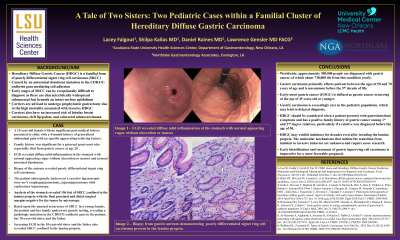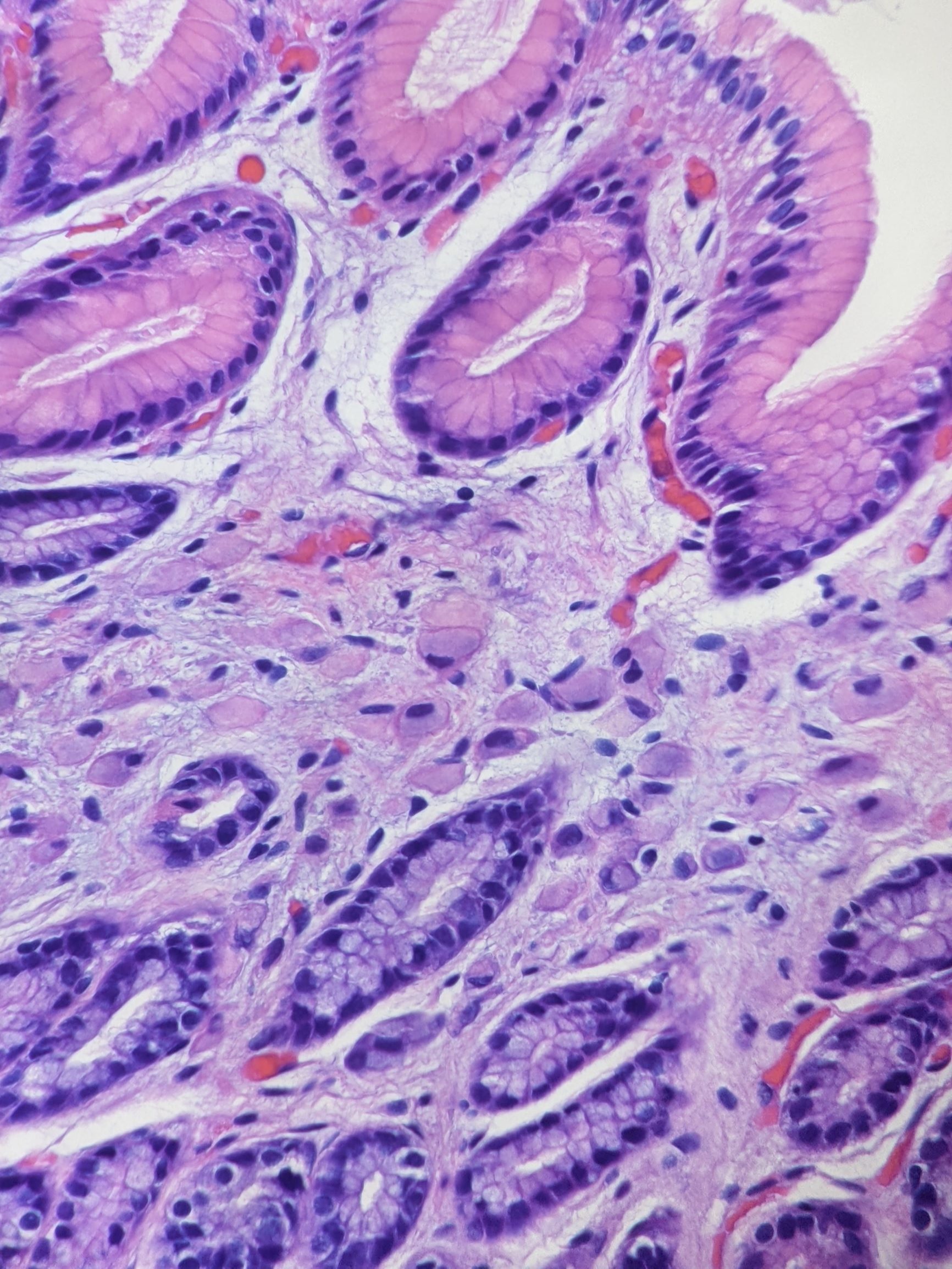Back


Poster Session D - Tuesday Morning
Category: Stomach
D0710 - A Tale of Two Sisters: Two Pediatric Cases Within a Familial Cluster of Hereditary Diffuse Gastric Carcinoma
Tuesday, October 25, 2022
10:00 AM – 12:00 PM ET
Location: Crown Ballroom

Has Audio

Lacey Falgout, BS
LSUHSC
Covington, LA
Presenting Author(s)
Lacey Falgout, BS1, Lawrence Gensler, MD2, Shilpa D. Kailas, MD3
1LSUHSC, Covington, LA; 2Northlake Gastroenterology Associates, Covington, LA; 3LSU, New Orleans, LA
Introduction: We report a case of HDGC in two sisters, (10 and 15 years old) and their father (41 years old).
Case Description/Methods: Our patient is a 15-year-old Caucasian female who initially presented to our clinic with a 4-month history of right lower quadrant tenderness and generalized abdominal pain, which she characterized as “stabbing pain”. Review of systems was significant for intermittent diarrhea and constipation. Family history was significant for a paternal great-aunt who reportedly died from gastric cancer at age 28. Abdominal ultrasound showed no significant abdominal pathology and no appreciable stomach wall thickening. EGD revealed diffuse mild inflammation of the stomach with normal appearing rugae without ulceration or masses and normal proximal duodenum. Biopsy results from the antrum revealed poorly differentiated signet ring cell carcinoma. The patient underwent a second EGD and imaging to confirm and stage the cancer. The patient subsequently underwent a laparoscopic roux-en-Y esophagojejunostomy, jejunojejunostomy with exploratory laparoscopy. Based upon the unusual occurrence of SRCC in a young female, the patient and her family underwent genetic testing. The patient was found to be positive for a CDH1/E-cadherin mutation. It was found that the patient’s father and her 10-year-old sister also carried this mutation. The 10-year-old sister and the father underwent screening EGD with greater than 40 biopsies taken throughout the stomach, esophagus, and duodenum in representative areas. Surprisingly, both patients were found also to have gastric SRCC. The father has since undergone chemotherapy, radiation, and a laparoscopic roux-en-Y esophagojejunostomy, jejunojejunostomy. The family is opting for conservative management at this time for the 10-year-old patient with plans to undergo the same surgery when she is older.
Discussion: Gastric carcinoma in the pediatric population is exceedingly rare. HDGC should be considered when a patient presents with gastrointestinal symptoms and has a positive family history of gastric cancer among 1st and 2nd degree relatives, particularly if a relative was diagnosed before the age of 50. For carriers of the CDH1 mutation, prophylactic total gastrectomy is recommended with intraoperative confirmation of squamous epithelium in the esophagus at the proximal margin and duodenal mucosa at the distal margin. If gastrectomy is contraindicated, yearly endoscopic surveillance with random biopsies is recommended.

Disclosures:
Lacey Falgout, BS1, Lawrence Gensler, MD2, Shilpa D. Kailas, MD3. D0710 - A Tale of Two Sisters: Two Pediatric Cases Within a Familial Cluster of Hereditary Diffuse Gastric Carcinoma, ACG 2022 Annual Scientific Meeting Abstracts. Charlotte, NC: American College of Gastroenterology.
1LSUHSC, Covington, LA; 2Northlake Gastroenterology Associates, Covington, LA; 3LSU, New Orleans, LA
Introduction: We report a case of HDGC in two sisters, (10 and 15 years old) and their father (41 years old).
Case Description/Methods: Our patient is a 15-year-old Caucasian female who initially presented to our clinic with a 4-month history of right lower quadrant tenderness and generalized abdominal pain, which she characterized as “stabbing pain”. Review of systems was significant for intermittent diarrhea and constipation. Family history was significant for a paternal great-aunt who reportedly died from gastric cancer at age 28. Abdominal ultrasound showed no significant abdominal pathology and no appreciable stomach wall thickening. EGD revealed diffuse mild inflammation of the stomach with normal appearing rugae without ulceration or masses and normal proximal duodenum. Biopsy results from the antrum revealed poorly differentiated signet ring cell carcinoma. The patient underwent a second EGD and imaging to confirm and stage the cancer. The patient subsequently underwent a laparoscopic roux-en-Y esophagojejunostomy, jejunojejunostomy with exploratory laparoscopy. Based upon the unusual occurrence of SRCC in a young female, the patient and her family underwent genetic testing. The patient was found to be positive for a CDH1/E-cadherin mutation. It was found that the patient’s father and her 10-year-old sister also carried this mutation. The 10-year-old sister and the father underwent screening EGD with greater than 40 biopsies taken throughout the stomach, esophagus, and duodenum in representative areas. Surprisingly, both patients were found also to have gastric SRCC. The father has since undergone chemotherapy, radiation, and a laparoscopic roux-en-Y esophagojejunostomy, jejunojejunostomy. The family is opting for conservative management at this time for the 10-year-old patient with plans to undergo the same surgery when she is older.
Discussion: Gastric carcinoma in the pediatric population is exceedingly rare. HDGC should be considered when a patient presents with gastrointestinal symptoms and has a positive family history of gastric cancer among 1st and 2nd degree relatives, particularly if a relative was diagnosed before the age of 50. For carriers of the CDH1 mutation, prophylactic total gastrectomy is recommended with intraoperative confirmation of squamous epithelium in the esophagus at the proximal margin and duodenal mucosa at the distal margin. If gastrectomy is contraindicated, yearly endoscopic surveillance with random biopsies is recommended.

Figure: Biopsy from gastric antrum demonstrating poorly differentiated signet ring cell carcinoma present in the lamina propria.
Disclosures:
Lacey Falgout indicated no relevant financial relationships.
Lawrence Gensler indicated no relevant financial relationships.
Shilpa Kailas indicated no relevant financial relationships.
Lacey Falgout, BS1, Lawrence Gensler, MD2, Shilpa D. Kailas, MD3. D0710 - A Tale of Two Sisters: Two Pediatric Cases Within a Familial Cluster of Hereditary Diffuse Gastric Carcinoma, ACG 2022 Annual Scientific Meeting Abstracts. Charlotte, NC: American College of Gastroenterology.
